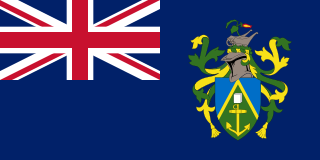
The Pitcairn Islands, officially Pitcairn, Henderson, Ducie and Oeno Islands, are a group of four volcanic islands in the southern Pacific Ocean that form the sole British Overseas Territory in the Pacific Ocean. The four islands—Pitcairn, Henderson, Ducie and Oeno—are scattered across several hundred kilometres of ocean and have a combined land area of about 47 square kilometres. Henderson Island accounts for 86% of the land area, but only Pitcairn Island is inhabited. The inhabited islands nearest to the Pitcairn Islands are Mangareva, 688 km to the west, as well as Easter Island, 1,929 km to the east.

The mutiny on the Royal Navy vessel HMS Bounty occurred in the South Pacific Ocean on 28 April 1789. Disaffected crewmen, led by acting-Lieutenant Fletcher Christian, seized control of the ship from their captain, Lieutenant William Bligh, and set him and eighteen loyalists adrift in the ship's open launch. The reasons behind the mutiny are still debated. Bligh and his crew stopped for supplies on Tofua, where a crew member was killed. Bligh navigated more than 3,500 nautical miles in the launch to reach safety and began the process of bringing the mutineers to justice. The mutineers variously settled on Tahiti or on Pitcairn Island.
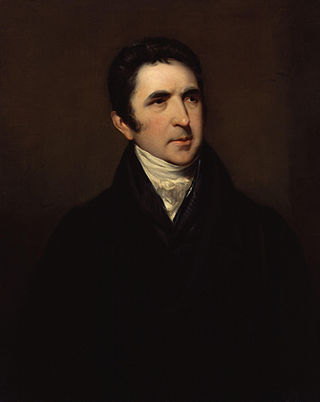
Sir John Barrow, 1st Baronet, was an English geographer, linguist, writer and civil servant best known for serving as the Second Secretary to the Admiralty from 1804 until 1845.
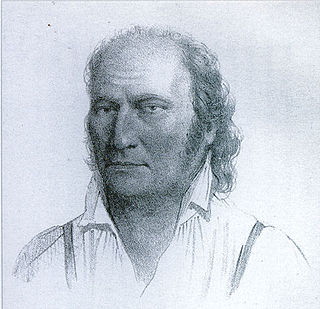
John Adams, known as Jack Adams, was the last survivor of the Bounty mutineers who settled on Pitcairn Island in January 1790, the year after the mutiny. His real name was John Adams, but he used the name Alexander Smith until he was discovered in 1808 by Captain Mayhew Folger of the American whaling ship Topaz. His children used the surname "Adams".

Adamstown is the capital and only settlement of the Pitcairn Islands, the only British Overseas Territory that is located in the southern Pacific Ocean.

The history of the Pitcairn Islands begins with the colonization of the islands by Polynesians in the 11th century. Polynesian people established a culture that flourished for four centuries and then vanished. They lived on Pitcairn and Henderson Islands, and on Mangareva Island 540 kilometres (340 mi) to the northwest, for about 400 years.

Fletcher Christian was an English sailor who led the mutiny on the Bounty in 1789, during which he seized command of the Royal Navy vessel HMS Bounty from Lieutenant William Bligh.

HMS Pandora was a 24-gun Porcupine-class sixth-rate post ship of the Royal Navy launched in May 1779. The vessel is best known for its role in hunting down the Bounty mutineers in 1790, which remains one of the best-known stories in the history of seafaring. Pandora was partially successful by capturing 14 of the mutineers, but wrecked on the Great Barrier Reef on the return voyage in 1791. HMS Pandora is considered to be one of the most significant shipwrecks in the Southern Hemisphere.

Mayhew Folger was an American whaler who captained the sealing ship Topaz that rediscovered the Pitcairn Islands in 1808, whilst one of HMS Bounty's mutineers was still living.
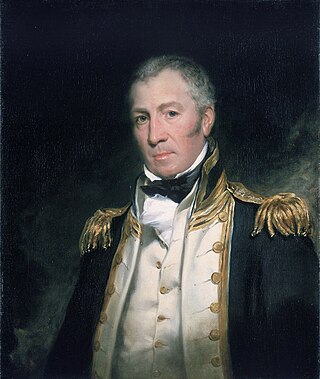
Captain Peter Heywood was a British Royal Navy officer who was on board HMS Bounty during the mutiny of 28 April 1789. He was later captured in Tahiti, tried and condemned to death as a mutineer, but subsequently pardoned. He resumed his naval career and eventually retired with the rank of post-captain, after 29 years of honourable service.
James Morrison was a British seaman and mutineer who took part in the Mutiny on the Bounty.

The descendants of the Bounty mutineers include the modern-day Pitcairn Islanders as well as a little less than half of the population of Norfolk Island. Their common ancestors were the nine surviving mutineers from the mutiny on HMS Bounty which occurred in the south Pacific Ocean in 1789. Their descendants also live in New Zealand, Australia, and the United States.

Pitcairn's Island is the third installment in the fictional trilogy by Charles Nordhoff and James Norman Hall about the mutiny aboard HMS Bounty. It is preceded by Mutiny on the "Bounty" and Men Against the Sea. The novel first appeared in The Saturday Evening Post then was published in 1934 by Little, Brown and Company. Chapters I–XV are told in the third person, and Chapters XVI–XXI are told in the first person by John Adams. The epilogue that follows is in the third person.
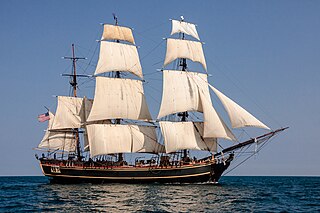
HMS Bounty, also known as HM Armed Vessel Bounty, was a British merchant ship that the Royal Navy purchased in 1787 for a botanical mission. The ship was sent to the South Pacific Ocean under the command of William Bligh to acquire breadfruit plants and transport them to the British West Indies. That mission was never completed owing to a 1789 mutiny led by acting lieutenant Fletcher Christian, an incident now popularly known as the Mutiny on the Bounty. The mutineers later burned Bounty while she was moored at Pitcairn Island in the Southern Pacific Ocean in 1790. An American adventurer helped land several remains of Bounty in 1957.

Pitcairn Island Museum is a museum in Pitcairn Island, a British Overseas Territory in the southern Pacific Ocean. Established in 2005, the museum's collection includes archaeological material from the earliest Polynesian settlers, as well as artefacts from HMS Bounty.

The Bounty Bible is a Bible that is thought to have been used on HMS Bounty, the ship famed for the Mutiny on the Bounty.

The complement of HMS Bounty, the Royal Navy ship on which a historic mutiny occurred in the south Pacific on 28 April 1789, comprised 46 men on its departure from England in December 1787 and 44 at the time of the mutiny, including her commander Lieutenant William Bligh. All but two of those aboard were Royal Navy personnel; the exceptions were two civilian botanists engaged to supervise the breadfruit plants Bounty was tasked to take from Tahiti to the West Indies. Of the 44 aboard at the time of the mutiny, 19 were set adrift in the ship's launch, while 25, a mixture of mutineers and detainees, remained on board under Fletcher Christian. Bligh led his loyalists 3,500 nautical miles to safety in the open boat, and ultimately back to England. The mutineers divided—most settled on Tahiti, where they were captured by HMS Pandora in 1791 and returned to England for trial, while Christian and eight others evaded discovery on Pitcairn Island.
Rosalind Amelia Young was a historian from Pitcairn Islands.

Teraura, also Susan or Susannah Young, was a Tahitian woman who settled on Pitcairn Island with the Bounty Mutineers. She took part in Ned Young's plot to murder male Polynesians who had travelled on HMS Bounty and killed Tetahiti. A tapa maker, examples of her craft are found in the British Museum and at Kew Gardens.

Mauatua, also Maimiti or Isabella Christian, also known as Mainmast, was a Tahitian tapa maker, who settled on Pitcairn Island with the Bounty mutineers. She married both Fletcher Christian and Ned Young, and had children with both men. Fine white tapa, which was her specialty, is held in the collections of the British Museum and the Pitt Rivers Museum, amongst others.


















